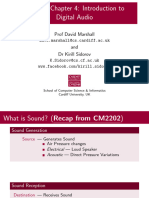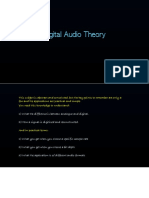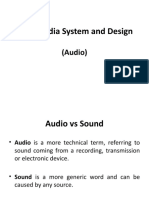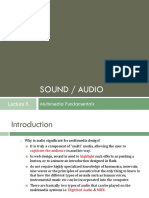0% found this document useful (0 votes)
21 views11 pagesAudio Basics
Digital audio is the conversion of sound into numerical data for processing and storage, involving sampling, quantization, and encoding. Key concepts include the Nyquist Theorem for accurate signal reproduction, bit depth for sound resolution, and various audio compression techniques. Digital audio has applications in music production, telecommunications, streaming services, and audio processing.
Uploaded by
advaithmanoj10Copyright
© © All Rights Reserved
We take content rights seriously. If you suspect this is your content, claim it here.
Available Formats
Download as PDF, TXT or read online on Scribd
0% found this document useful (0 votes)
21 views11 pagesAudio Basics
Digital audio is the conversion of sound into numerical data for processing and storage, involving sampling, quantization, and encoding. Key concepts include the Nyquist Theorem for accurate signal reproduction, bit depth for sound resolution, and various audio compression techniques. Digital audio has applications in music production, telecommunications, streaming services, and audio processing.
Uploaded by
advaithmanoj10Copyright
© © All Rights Reserved
We take content rights seriously. If you suspect this is your content, claim it here.
Available Formats
Download as PDF, TXT or read online on Scribd
/ 11























































